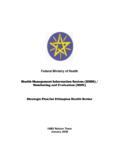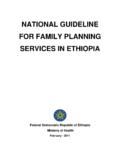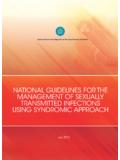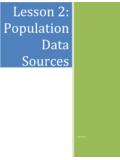Transcription of Ethiopia - World Health Organization
1 Pharmaceutical Sector Country Profile Questionnaire Ethiopia Pharmaceutical Sector Country Profile Questionnaire. Final Version. Page 2 The Pharmaceutical Sector Country Profile survey 1. Background and Rationale: Pharmaceutical Sector Country Profiles aim to increase the availability of quality information on structures, processes and outcomes of Health and pharmaceutical sectors of countries. This information will be collected through a questionnaire and is meant to be used by country decision-makers, Health and pharmaceutical experts, international partners and the public through databases and published country, regional and global reports. The information is categorized in nine sections, namely: (1) Health and Demographic data, (2) Health Services, (3) Medicines Policies, (4) Medicines Trade and Production, (5) Medicines Regulation, (6) Medicines Financing, (7) Pharmaceutical Procurement and distribution, (8) Selection and Rational Use and (9) Household data/access.
2 Every four years since 1999, Health officials from the 193 WHO Member States have been invited to complete a standardized questionnaire (named Level I) reporting on the status of the national pharmaceutical situation. Level I indicators assessed structures and processes related to the pharmaceutical situation of a country. They were used to carry out a rapid assessment that would highlight strengths and weaknesses of countries pharmaceutical situations. 156 countries responded to the 2007 level I survey and the results were stored and available in a global WHO database and used to develop a global report as well as a number of regional and sub-regional reports. The Pharmaceutical Sector Country Profile questionnaire described here will replace the Level I tool for the 2011 Member States' survey . The aim of this new approach is to build on the achievements and lessons learnt from the Level I tools and surveys and to improve the quality and scope of information ( , outcomes and results indicators) and enhance the involvement and ownership of countries in the development of profiles.
3 The new tool has been piloted in the 15 countries of the Southern African Development Community in 2009 and in 13 countries across the World in 2010. The results of these pilots are available on-line at: Another innovation of the 2011 survey is the collaboration between WHO and The Global Fund. In 2009, the Global Fund developed and introduced the Pharmaceutical and Health Product Management ("PHPM") Country Profile to gradually replace the Procurement and Supply Management ("PSM") Plan. In the course of 2010 both agencies have developed a joint Pharmaceutical Sector Country Profile questionnaire that includes key indicators of the Pharmaceutical Sector Country Profile Questionnaire. Final Version. Page 3 pharmaceutical sector and that will be used by both agencies as the sole tool for pharmaceutical sector data collection in countries. The information captured in the Pharmaceutical Sector Country Profile questionnaire will be used by the Global Fund during grant negotiations and signing, and will also support grant implementation.
4 In addition to the Country Profile that provides an overview of countries' pharmaceutical sectors, the Global Fund will also use a second questionnaire that will focus in more detail on medicines procurement and supply. 2. What can Pharmaceutical Sector Country Profiles offer: Completing this questionnaire will require the time of national experts and responsible officers but it is worthwhile as your country and your partners will benefit from it in a number of ways: I) The questionnaire offers a unique opportunity to consolidate, in one place, information that is available in different locations and institutions the National Medicines Regulatory Authority, Central Medical Stores, National Health Accounts, etc. II) The methodology proposed for filling in the questionnaire will ensure that good quality data are collected and that the source and date of information are known and reported. III) Data on structure, process and outcomes are collected, and the questionnaire has been pre-filled with data available in the public domain; indicators are divided into core and supplementary in order to make it easier to identify what is more important.
5 IV) The data collected will highlight the strengths and weaknesses of the pharmaceutical sector and will be made available in a national database as official country information, for use by decision-makers, Health and pharmaceutical experts, researchers and international partners and the V) The data collected could be transformed into a narrative report with robust data analysis and bibliographic references, that will summarize the medicines situation in the country. VI) Based on experiences from previous surveys, a detailed glossary of key definitions and a manual for use of the questionnaire have been developed and can be found at the end of the questionnaire. Pharmaceutical Sector Country Profile Questionnaire. Final Version. Page 4 3. The process of data collection and analysis: Data collection. The Pharmaceutical Sector Country Profile questionnaire has already been filled in by WHO with reliable data available from global and country sources.
6 We kindly ask you to review, to correct (if necessary) and to validate the information already included in the questionnaire, and also to fill in the gaps, based on reliable information available in your country. In order to do this, we recommend that you involve the most appropriate respondents and responsible institutions to fill in the various components of the tool so that the questionnaire is completed within the given deadline, with good quality information. If during the data collection process, clarifications are needed, WHO Regional and Headquarters Offices will provide the necessary assistance and support, including for data quality issues. Official endorsement. Once the questionnaire has been completed, the information contained in it should be officially endorsed and its disclosure authorized by a senior official in the Ministry of Health . This should be done by signing the formal endorsement form attached to the questionnaire.
7 This will ensure that the quality of the information contained in the Pharmaceutical Sector Country Profile questionnaire is certified by the country. Data shared with the Global Fund. Data collected from Global Fund priority countries will be shared with the Global Fund and it will be used as part of the Global Fund's own grant signing and implementation procedures. Data posted on key databases. Data endorsed by the country will be posted on Health databases (such as the WHO Global Health Observatory, ), making it available to decision-makers, Health and medicines experts and researchers, international partners and the public. Pharmaceutical Sector Country Profile Questionnaire. Final Version. Page 5 Development of narrative Pharmaceutical Sector Country Profiles. Data provided within the country questionnaire can be used by the country to develop a narrative profile that will illustrate the national pharmaceutical sector.
8 In order to do this, WHO has prepared a template profile (included in the CD-Rom shared with you) that can be easily used by countries and that will help presenting data in the form of tables, graphs and charts. Countries could seek support from WHO for the development of their narrative profile, which will be finalized and validated by the country that will own the copyright for it and will publish it as a national official document. Development of Regional and Global Reports. The information provided by countries in the Pharmaceutical Sector Country Profile questionnaire will be analysed by WHO and used to produce regional and global reports on the pharmaceutical sector of countries in 2011. These reports will provide an overview of the progress made between 2007 and 2011, of the challenges that remain to be addressed and will include data analysis by technical areas, countries' income level and geographical location. Pharmaceutical Sector Country Profile Questionnaire.
9 Final Version. Page 6 Guidelines for countries on how to fill in the Pharmaceutical Sector Country Profile Questionnaire Please read these instructions carefully before starting data collection 1. Macros: the questionnaire has macros installed. A macro is a series of MS Word commands and instructions that are grouped together as a single command to accomplish a task automatically. For these macros to work properly, the macro security levels for MS Word on your computer should be set as 'low'. This can be easily adjusted by taking the following steps: 1. Open the Word document containing the instrument. 2. Go to 'Tools' > 'Macro' > 'Security'. 3. Click on the tab 'Security Level'. 4. Set the Security on 'Low' and click 'OK'. After filling in the questionnaire, the setting should be restored to a higher level of security in order to protect your computer. 2. Core and supplementary indicators: the instrument consists of core and supplementary questions. Core questions cover the most important information, while supplementary questions deal with more specific information applicable to particular sections.
10 Please note that core questions have been shaded with different coloured backgrounds for different sections of the instrument, while supplementary questions are all white. This should help you to distinguish between the different categories of indicators. Please try to fill in all the core questions for each section before moving to the supplementary ones. Remember that we are only asking you to collect information that is already available and you are not expected to conduct any additional survey (s). 3. Prefilled data: the answers to some of the questions have been prefilled by WHO HQ. Where this is the case, please verify this information as it may not be up-to-date. If you find that any of the prefilled responses are not correct, please change the value and document the source and year. Pharmaceutical Sector Country Profile Questionnaire. Final Version. Page 7 4. Calculated fields: for a few items, you will not be required to enter any value as these will be generated at WHO HQ using data entered into related fields.
















